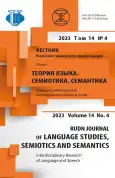Two-word Utterances in the Speech of Young Children: Gender Aspect according to MacArthur-Bates Communicative Development Inventories
- 作者: Eliseeva M.B.1, Vershinina E.A.2
-
隶属关系:
- Herzen State Pedagogical University of Russia
- Pavlov Institute of Physiology, Russian Academy of Sciences
- 期: 卷 14, 编号 4 (2023): INTERDISCIPLINARY RESEARCH OF LANGUAGE AND SPEECH
- 页面: 1050-1066
- 栏目: INTERDISCIPLINARY ASPECTS OF CHILDREN’S SPEECH STUDIES
- URL: https://journal-vniispk.ru/2313-2299/article/view/323618
- DOI: https://doi.org/10.22363/2313-2299-2023-14-4-1050-1066
- EDN: https://elibrary.ru/DNFJRI
- ID: 323618
如何引用文章
全文:
详细
The appearance of two-component utterances in children’s speech is one of the key stages of speech ontogenesis. The transition from separate lexemes to sentences is a cardinal event associated not only with the development of speech skills, but also with cognitive development. Previous studies based on longitudinal data have shown that two-word utterances appear from the age of one and a half to two years. Gender differences in the acquisition of this skill have never been considered. What is new in this study is that the results are based on an analysis of a representative database of children of both sexes, as well as separately boys and girls. For the first time, the norms of syntactic development were statistically substantiated and risk groups were identified. The material of the study was a database based on 1037 MacArthur questionnaires completed by parents (487 boys and 550 girls aged 18 to 36 months). The main results confirmed the age of appearance of utterances from one and a half to two years, but important nuances were revealed. Number of girls of 19 months, whose speech contains phrases, is twice the number of boys, and the differences are statistically significant). However, at the age of 20 months the boys are chasing the girls. Then the girls are slightly ahead, but we only observe significance at 23-month age. Girls, whose results refer to the median, say utterances at 20 months, and «median» boys - about 22-month age. The risk groups are different: we see a significant delay (children in the 5th percentile) in boys at the age of 25 months and in girls at 23-month age: they do not combine words into sentences. Comparison of the results of Russian-speaking children with the results of children speaking several other languages (according to scientific literature) confirmed the opinion about the typical age of the appearance of double-syntaxemic sentences. The results obtained are valid and reliable, therefore they are valuable in diagnosing the speech development of young children, as well as in conducting scientific research at this stage.
作者简介
Marina Eliseeva
Herzen State Pedagogical University of Russia
编辑信件的主要联系方式.
Email: melyseeva@yandex.ru
ORCID iD: 0000-0003-0564-668X
PhD, the Head of the Department of Children’s Language and Literary Education
48, Moika Embankment, St. Petersburg, Russian Federation, 191186Elena Vershinina
Pavlov Institute of Physiology, Russian Academy of Sciences
Email: ver_elen@mail.ru
ORCID iD: 0000-0002-8873-4409
Senior Researcher
6, Makarovа Embankment, St. Petersburg, Russian Federation, 199034参考
- Cejtlin, S.N. (2013). Linguistic studies. Saint-Petersburg: RGPU n.a. A.I. Gercen publ. (In Russ.).
- Bloom, L. (1973). One Word at a Time: the Use of Single Word Utterances before Syntax. The Hague; Paris: Mouton Publishers. https://doi.org/10.7916/D8H995NS
- Ahutina, T.V. (2021). Studies of the generation and perception of speech in Russian psycholinguistics. In: Russian psycholinguistics: results and prospects (1966–2021): Collective monograph. Moscow: Institute of Linguistics. pp. 423–435. (In Russ.).
- Cejtlin, S.N. (2021). Language and child. Acquisition of native language by child. Moscow: Vlados. (In Russ.).
- Eliseeva, M.B. (2015). Formation of an Individual Language System of a Child: Early Stages: Monograph. Moscow: Languages of Slavic Culture. (In Russ.).
- Gvozdev, A.N. (2007). Questions of studying of child speech. Moscow: DETSTVO-PRESS. (In Russ.).
- Elivanova, V.A. (2003). Syntactic productivity of an utterance as an indicator of the transition from the stage of one-word utterances to the stage of two-word utterances. In: Correctional Pedagogy: Unified Educational Space: Collection of Scientific Methods. Proceedings. SaintPetersburg: RGPU n.a. A.I. Gercen publ. (In Russ.).
- Brown, R. & Fraser, C. (1963). The Acquisition of Syntax. In: C.N. Cofer & B.S. Musgrave (eds.) Verbal behavior and learning: Problems and processes. McGraw-Hill Book Company. pp. 158–209. https://doi.org/10.1037/11178-005
- Eliseeva, M.B. (2022). Two-word and multi-word utterances in early child speech: typical and individual. Problemy ontolingvistiki — 2022: rechevoj mir rebenka (universal’nye mekhanizmy i individual’nye processy): Materialy ezhegodnoj mezhdunarodnoj nauchnoj konferencii, Sankt-Peterburg, 19–21 aprelya 2022 goda. Saint-Petersburg: VVM. pp. 85–91. (In Russ.).
- Berk, S. & Lillo-Martin, D. (2012). The two-word stage: motivated by linguistic or cognitive constraints? Cogn. Psychol., 65(1), 118–140. https://doi.org/10.1016/j. cogpsych.2012.02.002/2012
- Zhukova, N.S., Mastyukova, E.M. & Filicheva, T.B. (1990). Оvercoming general speech undevelopment in preschool children. Moscow: Prosveshchenie. (In Russ.).
- Eliseeva, M.B. (2005). The development of a child’s speech: a linguist’s point of view. Logoped, 4, 18–28. (In Russ.).
- Eliseeva, M.B. (2022). Speech development norms according to the diary and research works by A.N. Gvozdev’s and modern data. Russian language at school, 83(2), 7–11. https://doi.org/10.30515/0131-6141-2022-83-2-7-11 (In Russ.).
- Mayor, J. & Mani, N. (2019). A short version of the MacArthur–Bates Communicative Development Inventories with high validity. Behav. Res., 51, 2248–2255. https://doi.org/10.3758/s13428-018-1146-0
- Eliseeva, M.B., Vershinina, E.A. & Ryskina, V.L. (2021). MacArthur CDI: Russian version. Evaluation of the speech and communication development of young children. Development standards. Analysis samples. Comments. Ivanovo: LISTOS. (In Russ.).
- Fenson, L., Marchman, V.A., Thal, D.J., Dale, P., Reznick, J.S. & Bates, E. (2007). MacArthurBates Communicative Development Inventories: user`s guide and technical manual. Baltimor-London-Sydney.
- Eliseeva, M.B. & Vershinina, E.A. (2018). Can a child respond to questions? (based on the analysis of macarthur questionnaires and case study). Izvestia: Herzen University Journal of Humanities & Sciences, 189, 28–43. (In Russ.).
- Eliseeva, M.B. & Vershinina, E.A. (2020). Norms of grammatical categories acquisition by boys and girls at an early age (based on Macarthur questionnaire). Special Education, 1(57), 120–135. https://doi.org/10.26170/sp20-01-09 (In Russ.).
- Frank, M.C., Braginsky, M., Yurovsky, D. & Marchman, V.A. (2021). Variability and Consistency in Early Language Learning: The Wordbank Project. Cambridge, MA: MIT Press. URL: https://langcog.github.io/wordbank-book (accessed: 04.06.2023).
补充文件









